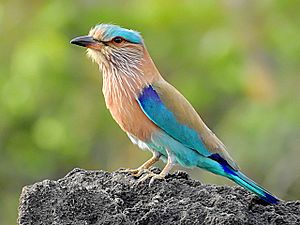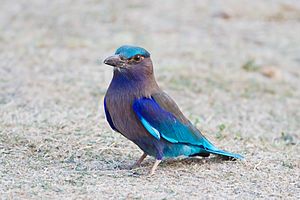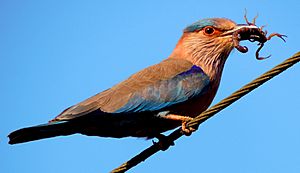Indian roller facts for kids
Quick facts for kids Indian roller |
|
|---|---|
 |
|
| C. b. indicus in Maharashtra, India | |
| Conservation status | |
| Scientific classification | |
| Genus: |
Coracias
|
| Species: |
benghalensis
|
| Synonyms | |
|
|
The Indian roller (Coracias benghalensis), is a member of the roller family of birds. They are found widely across tropical Asia from Iraq eastward across the Indian Subcontinent to Indochina and are best known for the aerobatic displays of the male during the breeding season. They are very commonly seen perched along roadside trees and wires and are commonly seen in open grassland and scrub forest habitats. It is not migratory, but undertakes some seasonal movements. The largest populations of the species are within India, and several states in India have chosen it as their state bird. They are best known for the aerobatic displays of the male during the breeding season. They are very commonly seen perched along roadside trees and wires and are commonly seen in open grassland and scrub forest habitats. It is not migratory, but undertakes some seasonal movements.
Distribution and habitat
The Indian roller is distributed across Asia, from Iraq and United Arab Emirates in south-western Asia through the Indian Subcontinent, including Sri Lanka, Lakshadweep islands and Maldive Islands into Southeast Asia. Its main habitat includes cultivated areas, thin forest and grassland.
Ecology and behaviour
Indian rollers are often seen perched on prominent bare trees or wires. They descend to the ground to capture their prey which may include insects, arachnids, small reptiles, small snakes and amphibians. Fires attract them and they will also follow tractors for disturbed invertebrates. In agricultural habitats in southern India, they have been found at densities of about 50 birds per km2.
They perch mainly on 3—10 metre high perches and feed mostly on ground insects. Nearly 50% of their prey are beetles and 25% made up by grasshoppers and crickets. During summer, they may also feed late in the evening and make use of artificial lights and feed on insects attracted to them. They are attracted to swarms of winged termites, and as many as 40 birds have been seen to perch on a 70-metre stretch of electric wires.
Their habit of feeding near roadsides sometimes results in collisions with traffic. A decline in the numbers of these birds seen along roadsides in northern India has been noted.
The display of this bird is an aerobatic display, with the twists and turns that give this species its English name. The breeding season is March to June, slightly earlier in southern India. Displays when perched include bill-up displays, bowing, allopreening, wing drooping and tail fanning.
Holes created by woodpeckers or wood boring insects in palms are favoured for nesting in some areas. Nest cavities may also be made by tearing open rotten tree trunks or in cavities in building. The cavity is usually unlined and is made up mainly of debris from the wood. The normal clutch consists of about 3-5 eggs. The eggs are white and broad oval or nearly spherical. Both sexes incubate the eggs for about 17 to 19 days. The young fledge and leave the nest after about a month. Nearly 80% of the eggs hatch and fledge.
The call of the Indian roller is a harsh crow-like chack sound. It also makes a variety of other sounds, including metallic boink calls. It is especially vociferous during the breeding season. The bird bathes in open water by plunge-diving into it, a behaviour often interpreted as fishing. But it may occasionally attempt fishing from water.
In culture
The Indian roller is very common in the populated plains of India and associated with legends. It is said to be sacred to Vishnu, and used to be caught and released during festivals such as Dussera and Durga Puja. A local Hindi name is neelkanth, meaning "blue throat", a name associated with the deity Shiva (who drank poison resulting in the blue throat).
The Indian roller has been chosen as the state bird by the Indian states of Andhra Pradesh, Odisha, Karnataka and Telangana.
Images for kids
See also
 In Spanish: Carraca india para niños
In Spanish: Carraca india para niños









